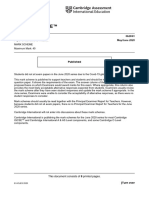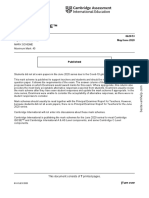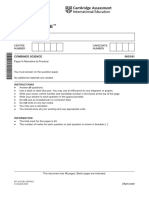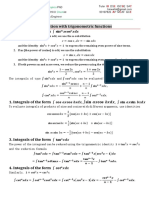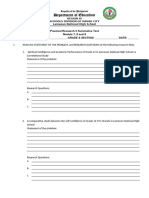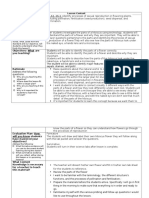Cambridge IGCSE™: Combined Science 0653/61 May/June 2020
Cambridge IGCSE™: Combined Science 0653/61 May/June 2020
Uploaded by
Hin Wa LeungCopyright:
Available Formats
Cambridge IGCSE™: Combined Science 0653/61 May/June 2020
Cambridge IGCSE™: Combined Science 0653/61 May/June 2020
Uploaded by
Hin Wa LeungOriginal Title
Copyright
Available Formats
Share this document
Did you find this document useful?
Is this content inappropriate?
Copyright:
Available Formats
Cambridge IGCSE™: Combined Science 0653/61 May/June 2020
Cambridge IGCSE™: Combined Science 0653/61 May/June 2020
Uploaded by
Hin Wa LeungCopyright:
Available Formats
Cambridge IGCSE™
COMBINED SCIENCE 0653/61
Paper 6 Alternative to Practical May/June 2020
MARK SCHEME
Maximum Mark: 40
Published
Students did not sit exam papers in the June 2020 series due to the Covid-19 global pandemic.
This mark scheme is published to support teachers and students and should be read together with the
question paper. It shows the requirements of the exam. The answer column of the mark scheme shows the
proposed basis on which Examiners would award marks for this exam. Where appropriate, this column also
provides the most likely acceptable alternative responses expected from students. Examiners usually review
the mark scheme after they have seen student responses and update the mark scheme if appropriate. In the
June series, Examiners were unable to consider the acceptability of alternative responses, as there were no
student responses to consider.
Mark schemes should usually be read together with the Principal Examiner Report for Teachers. However,
because students did not sit exam papers, there is no Principal Examiner Report for Teachers for the June
2020 series.
Cambridge International will not enter into discussions about these mark schemes.
Cambridge International is publishing the mark schemes for the June 2020 series for most Cambridge
IGCSE™ and Cambridge International A & AS Level components, and some Cambridge O Level
components.
This document consists of 7 printed pages.
© UCLES 2020 [Turn over
0653/61 Cambridge IGCSE – Mark Scheme May/June 2020
PUBLISHED
Generic Marking Principles
These general marking principles must be applied by all examiners when marking candidate answers. They should be applied alongside the
specific content of the mark scheme or generic level descriptors for a question. Each question paper and mark scheme will also comply with these
marking principles.
GENERIC MARKING PRINCIPLE 1:
Marks must be awarded in line with:
• the specific content of the mark scheme or the generic level descriptors for the question
• the specific skills defined in the mark scheme or in the generic level descriptors for the question
• the standard of response required by a candidate as exemplified by the standardisation scripts.
GENERIC MARKING PRINCIPLE 2:
Marks awarded are always whole marks (not half marks, or other fractions).
GENERIC MARKING PRINCIPLE 3:
Marks must be awarded positively:
• marks are awarded for correct/valid answers, as defined in the mark scheme. However, credit is given for valid answers which go beyond the
scope of the syllabus and mark scheme, referring to your Team Leader as appropriate
• marks are awarded when candidates clearly demonstrate what they know and can do
• marks are not deducted for errors
• marks are not deducted for omissions
• answers should only be judged on the quality of spelling, punctuation and grammar when these features are specifically assessed by the
question as indicated by the mark scheme. The meaning, however, should be unambiguous.
GENERIC MARKING PRINCIPLE 4:
Rules must be applied consistently e.g. in situations where candidates have not followed instructions or in the application of generic level
descriptors.
© UCLES 2020 Page 2 of 7
0653/61 Cambridge IGCSE – Mark Scheme May/June 2020
PUBLISHED
GENERIC MARKING PRINCIPLE 5:
Marks should be awarded using the full range of marks defined in the mark scheme for the question (however; the use of the full mark range may
be limited according to the quality of the candidate responses seen).
GENERIC MARKING PRINCIPLE 6:
Marks awarded are based solely on the requirements as defined in the mark scheme. Marks should not be awarded with grade thresholds or
grade descriptors in mind.
Science-Specific Marking Principles
1 Examiners should consider the context and scientific use of any keywords when awarding marks. Although keywords may be present, marks
should not be awarded if the keywords are used incorrectly.
2 The examiner should not choose between contradictory statements given in the same question part, and credit should not be awarded for any
correct statement that is contradicted within the same question part. Wrong science that is irrelevant to the question should be ignored.
3 Although spellings do not have to be correct, spellings of syllabus terms must allow for clear and unambiguous separation from other syllabus
terms with which they may be confused (e.g. ethane / ethene, glucagon / glycogen, refraction / reflection).
4 The error carried forward (ecf) principle should be applied, where appropriate. If an incorrect answer is subsequently used in a scientifically
correct way, the candidate should be awarded these subsequent marking points. Further guidance will be included in the mark scheme where
necessary and any exceptions to this general principle will be noted.
© UCLES 2020 Page 3 of 7
0653/61 Cambridge IGCSE – Mark Scheme May/June 2020
PUBLISHED
5 ‘List rule’ guidance
For questions that require n responses (e.g. State two reasons …):
• The response should be read as continuous prose, even when numbered answer spaces are provided
• Any response marked ignore in the mark scheme should not count towards n
• Incorrect responses should not be awarded credit but will still count towards n
• Read the entire response to check for any responses that contradict those that would otherwise be credited. Credit should not be
awarded for any responses that are contradicted within the rest of the response. Where two responses contradict one another, this
should be treated as a single incorrect response
• Non-contradictory responses after the first n responses may be ignored even if they include incorrect science.
6 Calculation specific guidance
Correct answers to calculations should be given full credit even if there is no working or incorrect working, unless the question states ‘show
your working’.
For questions in which the number of significant figures required is not stated, credit should be awarded for correct answers when rounded by
the examiner to the number of significant figures given in the mark scheme. This may not apply to measured values.
For answers given in standard form, (e.g. a × 10n) in which the convention of restricting the value of the coefficient (a) to a value between 1
and 10 is not followed, credit may still be awarded if the answer can be converted to the answer given in the mark scheme.
Unless a separate mark is given for a unit, a missing or incorrect unit will normally mean that the final calculation mark is not awarded.
Exceptions to this general principle will be noted in the mark scheme.
7 Guidance for chemical equations
Multiples / fractions of coefficients used in chemical equations are acceptable unless stated otherwise in the mark scheme.
State symbols given in an equation should be ignored unless asked for in the question or stated otherwise in the mark scheme.
© UCLES 2020 Page 4 of 7
0653/61 Cambridge IGCSE – Mark Scheme May/June 2020
PUBLISHED
Question Answer Marks
1(a) 8/9; 1
1(b)(i) (surface area) cube B = 600 AND cube C = 150 ; 1
1(b)(ii) (volume) cube B = 1000 AND cube C = 125 ; 1
1(c)(i) (cube B) 145 ; 2
(cube C) 47 ;
1(c)(ii) time (to change colour to red) AND / s ; 1
1(c)(iii) increase in surface area to volume ratio takes less time to change / ORA ; 1
1(c)(iv) acid diffuses in ; 2
pH changes to acidic ;
1(c)(v) cutting AND use knife, on solid surface / away from body ; 1
OR
acid / indicator AND use, gloves / goggles ;
1(d)(i) suitable scale chosen ; 2
all points plotted correctly ;
1(d)(ii) suitable curve of best fit ; 1
Question Answer Marks
2(a)(i) (volumetric) pipette ; 1
2(a)(ii) (experiment 2) 5.9 ; 2
(experiment 3) 5.3 ;
© UCLES 2020 Page 5 of 7
0653/61 Cambridge IGCSE – Mark Scheme May/June 2020
PUBLISHED
Question Answer Marks
2(a)(iii) (volumes) 5.3 and 5.1 1
AND
(explanation) the others were not neutral / go orange at the end point / others had too much acid added ;
2(a)(iv) 5.2 / correct average calculated from their chosen volumes ; 1
2(a)(v) average calculated in (a)(iv) × 3 ; 1
2(a)(vi) neutralisation / acid-base ; 1
2(b)(i) (more concentrated solution) hydrochloric acid AND less used than sodium hydroxide ; 1
2(b)(ii) (25 / 5.2 =) 5 / 4.8 ; 1
2(c)(i) chloride / Cl – ; 1
2(c)(ii) sodium chloride ; 1
2(c)(iii) tripod and Bunsen burner and evaporating basin (and gauze) ; 2
two correct labels ;
Question Answer Marks
3(a)(i) line emerging at 90° to the straight edge and labelled X ; 1
3(a)(ii) 52(°) ;; 2
(if answer is incorrect allow one mark for answer in range of 49-55°)
3(b) any one from: 1
repeat AND average ;
use a dark room / low light level / use a bright light source ;
narrow beam of light / use of thin slit ;
avoid parallax error when taking measurements ;
© UCLES 2020 Page 6 of 7
0653/61 Cambridge IGCSE – Mark Scheme May/June 2020
PUBLISHED
Question Answer Marks
3(c) no AND reference to a pair of values from Table 3.1 ; 1
3(d) (estimate of critical angle =) answer greater than 40° and less than or equal to 50° ; 1
3(e) measure angle of refraction for angles of incidence in between 40° and 50° / carefully move the light source around the 1
curve back and forth to find the smallest angle of incidence where no light is refracted and measure this angle of
incidence ;
Question Answer Marks
4 one marking point from each section and any three others: 7
method and apparatus
fill tank with water to a specified depth (< 20 cm) ;
use of stopwatch / suitable timing device ;
repeat and take average for each depth ;
variables
keep method of producing waves the same ;
same water source / same environment ;
minimum of four values of depth of water given ;
values of depth have a range of at least 15 cm AND do not exceed 20 cm maximum depth ;
results
time for the waves to travel length of tank AND depth of water ;
conclusion
calculation of speed of waves from the time measurements ;
use results to plot graph of depth against speed ;
look for pattern in the change of speed as depth increases ;
© UCLES 2020 Page 7 of 7
You might also like
- Perkins 2300 2306c-E14Document156 pagesPerkins 2300 2306c-E14Chakroune75% (8)
- Overview Fusion Welding Standards PDFDocument1 pageOverview Fusion Welding Standards PDFHà Việt Đức100% (1)
- Cambridge IGCSE™: Combined Science 0653/51 May/June 2020Document7 pagesCambridge IGCSE™: Combined Science 0653/51 May/June 2020Hin Wa LeungNo ratings yet
- Cambridge IGCSE™: Biology 0610/63 May/June 2020Document7 pagesCambridge IGCSE™: Biology 0610/63 May/June 2020bali yunNo ratings yet
- Cambridge IGCSE™: Combined Science 0653/63 May/June 2020Document7 pagesCambridge IGCSE™: Combined Science 0653/63 May/June 2020Hin Wa LeungNo ratings yet
- Cambridge IGCSE™ (9-1) : BIOLOGY (9-1) 0970/62 May/June 2020Document9 pagesCambridge IGCSE™ (9-1) : BIOLOGY (9-1) 0970/62 May/June 2020Anisa KhanamNo ratings yet
- Cambridge IGCSE™: Biology 0610/53 May/June 2020Document7 pagesCambridge IGCSE™: Biology 0610/53 May/June 2020Saleha ShafiqueNo ratings yet
- Cambridge IGCSE™: Combined Science 0653/42 May/June 2020Document11 pagesCambridge IGCSE™: Combined Science 0653/42 May/June 2020septinNo ratings yet
- Cambridge IGCSE™: Combined Science 0653/41 May/June 2020Document10 pagesCambridge IGCSE™: Combined Science 0653/41 May/June 2020Hin Wa LeungNo ratings yet
- Cambridge IGCSE™: Combined Science 0653/52 March 2020Document8 pagesCambridge IGCSE™: Combined Science 0653/52 March 2020Hin Wa LeungNo ratings yet
- Cambridge IGCSE™: Biology 0610/52 May/June 2020Document7 pagesCambridge IGCSE™: Biology 0610/52 May/June 2020Saleha ShafiqueNo ratings yet
- Cambridge IGCSE™: Combined Science 0653/32 May/June 2020Document10 pagesCambridge IGCSE™: Combined Science 0653/32 May/June 2020Hin Wa LeungNo ratings yet
- Cambridge IGCSE™: Combined Science 0653/62 February/March 2022Document8 pagesCambridge IGCSE™: Combined Science 0653/62 February/March 2022jesslynaureliaNo ratings yet
- Cambridge IGCSE™: Chemistry 0620/62 May/June 2020Document7 pagesCambridge IGCSE™: Chemistry 0620/62 May/June 2020kevalharsoda7No ratings yet
- Cambridge IGCSE™: Chemistry 0620/43 May/June 2020Document10 pagesCambridge IGCSE™: Chemistry 0620/43 May/June 2020JOHN MVULA IINo ratings yet
- Cambridge IGCSE™: Combined Science 0653/62 March 2020Document8 pagesCambridge IGCSE™: Combined Science 0653/62 March 2020Hin Wa LeungNo ratings yet
- Number 2 (0654 - s20 - Ms - 43)Document13 pagesNumber 2 (0654 - s20 - Ms - 43)Muhammad Luthfansyah PrabowoNo ratings yet
- Cambridge IGCSE™: Environmental Management 0680/21 October/November 2020Document12 pagesCambridge IGCSE™: Environmental Management 0680/21 October/November 2020Irtiza AbbasNo ratings yet
- Ans Paper 6Document7 pagesAns Paper 6suhaankochhar2008No ratings yet
- Cambridge IGCSE™ (9-1) : BIOLOGY (9-1) 0970/61 May/June 2020Document8 pagesCambridge IGCSE™ (9-1) : BIOLOGY (9-1) 0970/61 May/June 2020Anisa KhanamNo ratings yet
- Cambridge IGCSE™: Biology 0610/62 May/June 2022Document8 pagesCambridge IGCSE™: Biology 0610/62 May/June 2022walsha khanNo ratings yet
- Cambridge IGCSE™ (9-1) : BIOLOGY (9-1) 0970/51 May/June 2020Document8 pagesCambridge IGCSE™ (9-1) : BIOLOGY (9-1) 0970/51 May/June 2020Anisa KhanamNo ratings yet
- Cambridge IGCSE™ (9-1) : BIOLOGY (9-1) 0970/51 May/June 2020Document8 pagesCambridge IGCSE™ (9-1) : BIOLOGY (9-1) 0970/51 May/June 2020Anisa KhanamNo ratings yet
- Cambridge IGCSE™: Environmental Management 0680/11 May/June 2022Document15 pagesCambridge IGCSE™: Environmental Management 0680/11 May/June 2022chrismpod123No ratings yet
- Igcse Biology0610 Variant 2 May/june 2020Document12 pagesIgcse Biology0610 Variant 2 May/june 2020sally.mansterlyNo ratings yet
- Cambridge International AS & A Level: Chemistry 9701/23 May/June 2020Document11 pagesCambridge International AS & A Level: Chemistry 9701/23 May/June 2020orisunayo olugbengaNo ratings yet
- Cambridge IGCSE™: Combined Science 0653/42 March 2020Document10 pagesCambridge IGCSE™: Combined Science 0653/42 March 202058.Nguyễn Thị Diệu LinhNo ratings yet
- 0654 - s20 - Ms - 41 Mark SchemeDocument14 pages0654 - s20 - Ms - 41 Mark Schemek12engtutNo ratings yet
- Cambridge IGCSE™: Combined Science 0653/62 May/June 2020Document7 pagesCambridge IGCSE™: Combined Science 0653/62 May/June 2020Hin Wa LeungNo ratings yet
- June 2020 (v3) MS - Paper 4 CIE Chemistry GCSEDocument10 pagesJune 2020 (v3) MS - Paper 4 CIE Chemistry GCSEathmanNo ratings yet
- Cambridge International AS & A Level: Biology 9700/52 May/June 2020Document9 pagesCambridge International AS & A Level: Biology 9700/52 May/June 2020Aneeqa KhanNo ratings yet
- Cambridge IGCSE™: Chemistry 0620/31Document10 pagesCambridge IGCSE™: Chemistry 0620/31wokoba7588No ratings yet
- Cambridge IGCSE ™: Combined Science 0653/42 October/November 2022Document12 pagesCambridge IGCSE ™: Combined Science 0653/42 October/November 2022kavya pNo ratings yet
- Cambridge IGCSE™: Physics 0625/62 May/June 2020Document7 pagesCambridge IGCSE™: Physics 0625/62 May/June 2020fred.zyycNo ratings yet
- June 2022 Mark Scheme Paper 51Document9 pagesJune 2022 Mark Scheme Paper 51adannaajaegboNo ratings yet
- Cambridge IGCSE™: Co-Ordinated Sciences 0654/43 October/November 2020Document12 pagesCambridge IGCSE™: Co-Ordinated Sciences 0654/43 October/November 2020Orangess GirlNo ratings yet
- Cambridge IGCSE™: Chemistry 0620/61 May/June 2020Document8 pagesCambridge IGCSE™: Chemistry 0620/61 May/June 2020terencechen1225No ratings yet
- Cambridge IGCSE™: Combined Science 0653/42 March 2020Document10 pagesCambridge IGCSE™: Combined Science 0653/42 March 2020Hin Wa LeungNo ratings yet
- Cambridge IGCSE ™: PhysicsDocument8 pagesCambridge IGCSE ™: Physicsadnanrameen.1098No ratings yet
- Cambridge IGCSE™ (9-1) : Co-Ordinated Sciences (9-1) 0973/62 May/June 2022Document10 pagesCambridge IGCSE™ (9-1) : Co-Ordinated Sciences (9-1) 0973/62 May/June 2022t.dyakivNo ratings yet
- 0680_s20_ms_12Document11 pages0680_s20_ms_12breshnaimran321No ratings yet
- Cambridge IGCSE™: Co-Ordinated Sciences 0654/42 May/June 2020Document13 pagesCambridge IGCSE™: Co-Ordinated Sciences 0654/42 May/June 2020Man Hol KwanNo ratings yet
- Cambridge International AS & A Level: Biology 9700/34 May/June 2022Document8 pagesCambridge International AS & A Level: Biology 9700/34 May/June 2022mariakhan.educationNo ratings yet
- Cambridge IGCSE™ (9-1) : BIOLOGY (9-1) 0970/42 May/June 2020Document11 pagesCambridge IGCSE™ (9-1) : BIOLOGY (9-1) 0970/42 May/June 2020pirateduser666No ratings yet
- Cambridge IGCSE™: Combined Science 0653/32 May/June 2022Document10 pagesCambridge IGCSE™: Combined Science 0653/32 May/June 2022Thelma MusvotaNo ratings yet
- Cambridge IGCSE™: Combined Science 0653/62Document8 pagesCambridge IGCSE™: Combined Science 0653/62arindams.soodNo ratings yet
- Cambridge IGCSE™: Physical Science 0652/51 October/November 2020Document8 pagesCambridge IGCSE™: Physical Science 0652/51 October/November 2020Inaarah KavadiasNo ratings yet
- November 2022 Mark Scheme Paper 31Document10 pagesNovember 2022 Mark Scheme Paper 31mokgethitshidi218No ratings yet
- O2 & O3 Bio Theory MsDocument12 pagesO2 & O3 Bio Theory Msyasmin khanNo ratings yet
- Cambridge IGCSE™: Chemistry 0620/43Document11 pagesCambridge IGCSE™: Chemistry 0620/43krishaNo ratings yet
- Cambridge O Level: Physics 5054/42Document9 pagesCambridge O Level: Physics 5054/42Rithika HimathNo ratings yet
- Cambridge International AS & A Level: Biology 9700/52 May/June 2020Document9 pagesCambridge International AS & A Level: Biology 9700/52 May/June 2020saliwe.muzavaziNo ratings yet
- Cambridge IGCSE™: Environmental Management 0680/22 May/June 2022Document11 pagesCambridge IGCSE™: Environmental Management 0680/22 May/June 2022accessoryace4No ratings yet
- Cambridge IGCSE ™: Co-Ordinated Sciences 0654/42 October/November 2022Document13 pagesCambridge IGCSE ™: Co-Ordinated Sciences 0654/42 October/November 2022xuanquynhle03.95No ratings yet
- June 2022 (v1) MS - Paper 6 CAIE Chemistry IGCSEDocument7 pagesJune 2022 (v1) MS - Paper 6 CAIE Chemistry IGCSEWaraidzo MajiriNo ratings yet
- Cambridge IGCSE™: Chemistry 0620/53 May/June 2020Document7 pagesCambridge IGCSE™: Chemistry 0620/53 May/June 2020Diah SantyNo ratings yet
- Cambridge IGCSE™: Combined Science 0653/31 May/June 2022Document11 pagesCambridge IGCSE™: Combined Science 0653/31 May/June 2022Thelma MusvotaNo ratings yet
- Cambridge IGCSE™: Environmental Management 0680/11 May/June 2020Document12 pagesCambridge IGCSE™: Environmental Management 0680/11 May/June 2020graceNo ratings yet
- Number 4 (0654 - w22 - Ms - 42)Document13 pagesNumber 4 (0654 - w22 - Ms - 42)Muhammad Luthfansyah PrabowoNo ratings yet
- Cambridge IGCSE™: Physics 0625/63 May/June 2020Document8 pagesCambridge IGCSE™: Physics 0625/63 May/June 2020Fajar AhmadNo ratings yet
- 0610 m22 Ms 32 PDFDocument11 pages0610 m22 Ms 32 PDFsolihinNo ratings yet
- Cambridge IGCSE: Combined Science 0653/41Document20 pagesCambridge IGCSE: Combined Science 0653/41Hin Wa LeungNo ratings yet
- Cambridge IGCSE: Combined Science 0653/62Document16 pagesCambridge IGCSE: Combined Science 0653/62Hin Wa LeungNo ratings yet
- Cambridge IGCSE: Combined Science 0653/52Document8 pagesCambridge IGCSE: Combined Science 0653/52Hin Wa LeungNo ratings yet
- Cambridge IGCSE: Combined Science 0653/42Document24 pagesCambridge IGCSE: Combined Science 0653/42Hin Wa LeungNo ratings yet
- Cambridge IGCSE: Combined Science 0653/61Document16 pagesCambridge IGCSE: Combined Science 0653/61Hin Wa LeungNo ratings yet
- Cambridge IGCSE™: Combined Science 0653/11 May/June 2020Document3 pagesCambridge IGCSE™: Combined Science 0653/11 May/June 2020Hin Wa LeungNo ratings yet
- Cambridge IGCSE™: Combined Science 0653/32 May/June 2020Document10 pagesCambridge IGCSE™: Combined Science 0653/32 May/June 2020Hin Wa LeungNo ratings yet
- Cambridge IGCSE: Combined Science 0653/52Document8 pagesCambridge IGCSE: Combined Science 0653/52Hin Wa LeungNo ratings yet
- Cambridge IGCSE™: Combined Science 0653/62 May/June 2020Document7 pagesCambridge IGCSE™: Combined Science 0653/62 May/June 2020Hin Wa LeungNo ratings yet
- Cambridge IGCSE: Combined Science 0653/51Document8 pagesCambridge IGCSE: Combined Science 0653/51Hin Wa LeungNo ratings yet
- Trigonometry Third Space Learning GCSE WorksheetDocument14 pagesTrigonometry Third Space Learning GCSE WorksheetHin Wa LeungNo ratings yet
- Cambridge IGCSE™: Combined Science 0653/41 May/June 2020Document10 pagesCambridge IGCSE™: Combined Science 0653/41 May/June 2020Hin Wa LeungNo ratings yet
- Combined Science: Number Key Number KeyDocument20 pagesCombined Science: Number Key Number KeyHin Wa LeungNo ratings yet
- Cambridge IGCSE™: Combined Science 0653/42 March 2020Document10 pagesCambridge IGCSE™: Combined Science 0653/42 March 2020Hin Wa LeungNo ratings yet
- Cambridge IGCSE™: Combined Science 0653/62 March 2020Document8 pagesCambridge IGCSE™: Combined Science 0653/62 March 2020Hin Wa LeungNo ratings yet
- 9.5a Integration by Trigonometric Substitution RayDocument12 pages9.5a Integration by Trigonometric Substitution RayHin Wa LeungNo ratings yet
- Cambridge IGCSE™: Combined Science 0653/22 March 2020Document3 pagesCambridge IGCSE™: Combined Science 0653/22 March 2020Hin Wa LeungNo ratings yet
- CBPS 1 Cell OrganellesDocument60 pagesCBPS 1 Cell OrganellesHin Wa LeungNo ratings yet
- Cambridge IGCSE™: Combined Science 0653/52 March 2020Document8 pagesCambridge IGCSE™: Combined Science 0653/52 March 2020Hin Wa LeungNo ratings yet
- 9.5 Integration by Trigonometric Substitution RayDocument19 pages9.5 Integration by Trigonometric Substitution RayHin Wa LeungNo ratings yet
- 9.4 Integration With Trigonometric FunctionsDocument17 pages9.4 Integration With Trigonometric FunctionsHin Wa LeungNo ratings yet
- 9.1 Basic Integration 4Document4 pages9.1 Basic Integration 4Hin Wa LeungNo ratings yet
- AutoCAD Electrical JIC Admin Course Syllabus SampleDocument3 pagesAutoCAD Electrical JIC Admin Course Syllabus Samplefadapow4uNo ratings yet
- EDS 06-0013 Grid and Primary Substation Earthing DesignDocument59 pagesEDS 06-0013 Grid and Primary Substation Earthing DesignShiva Naga KumarNo ratings yet
- ConArt12 Module 2Document23 pagesConArt12 Module 225641916100% (1)
- Practical Research 2 Summative Test (Module 7,8 9)Document2 pagesPractical Research 2 Summative Test (Module 7,8 9)REYMOND LABOR JR.No ratings yet
- Helicobacter Pylori English 2021Document31 pagesHelicobacter Pylori English 2021Thea BerteaNo ratings yet
- Complex Digital Signal Processing in TelecommunicationsDocument23 pagesComplex Digital Signal Processing in TelecommunicationssubuhpramonoNo ratings yet
- Cep Lesson Plan TemplateDocument8 pagesCep Lesson Plan Templateapi-502980552No ratings yet
- Ems System For Ip DslamDocument50 pagesEms System For Ip DslamPedroNo ratings yet
- Declaration For Power of Attorney: Privacy Act StatementDocument2 pagesDeclaration For Power of Attorney: Privacy Act StatementOneNation100% (2)
- "A Study On Impact of Motivation On Employee Performance": Met College of Management StudiesDocument10 pages"A Study On Impact of Motivation On Employee Performance": Met College of Management StudiesDevaNo ratings yet
- Assam) .: Recent Passport Size Attested Photograph of The ApplicantDocument1 pageAssam) .: Recent Passport Size Attested Photograph of The Applicantdata manageNo ratings yet
- Vegan Products at SuperdrugDocument2 pagesVegan Products at SuperdrugVegan FutureNo ratings yet
- 124 Sample Risk Management Plan For Acat III and IVDocument23 pages124 Sample Risk Management Plan For Acat III and IVsupandipmpNo ratings yet
- Caraig, Danica G. - LP GRADE 9 (Joint Variation)Document7 pagesCaraig, Danica G. - LP GRADE 9 (Joint Variation)caraigikayNo ratings yet
- Nursing Patient InteractionDocument2 pagesNursing Patient InteractionAnneMyl's OL'ShoppeNo ratings yet
- First Conditional (Exercises) : If You Eat Too MuchDocument1 pageFirst Conditional (Exercises) : If You Eat Too MuchsophilauNo ratings yet
- Lizard® M8 Advanced NDE SystemDocument3 pagesLizard® M8 Advanced NDE Systemmelbry melNo ratings yet
- Summary Ifsb Puteri F1025Document5 pagesSummary Ifsb Puteri F1025Siti Nur QamarinaNo ratings yet
- Histology of KidneyDocument4 pagesHistology of KidneyIzzi FekratNo ratings yet
- University of California PressDocument41 pagesUniversity of California PressSoad KhanNo ratings yet
- 50V, 6A Rectifier: Package Dimensions ApplicationsDocument4 pages50V, 6A Rectifier: Package Dimensions ApplicationsAmanda AldanaNo ratings yet
- 5-Latest EIC-B-1001-0 ( - PVR - Series Single Vane Pumps)Document29 pages5-Latest EIC-B-1001-0 ( - PVR - Series Single Vane Pumps)RAYNo ratings yet
- Agitator Chemineer Mixer 2Document4 pagesAgitator Chemineer Mixer 2Tan Chee MingNo ratings yet
- Atc 1 of 2019Document25 pagesAtc 1 of 2019sadiq arshadNo ratings yet
- So Lesson Plan 2 TechnologyDocument22 pagesSo Lesson Plan 2 Technologyapi-309886906No ratings yet
- Precociou S Puberty: BY Vishnupriya Ravimohandoss Year-6 Group-1Document31 pagesPrecociou S Puberty: BY Vishnupriya Ravimohandoss Year-6 Group-1Priya RaviNo ratings yet
- Schedule 4 Work Program and Schedule PDFDocument22 pagesSchedule 4 Work Program and Schedule PDFamuronegadu100% (1)
- Sample ReportDocument38 pagesSample Reportshubhibaghel200No ratings yet




































